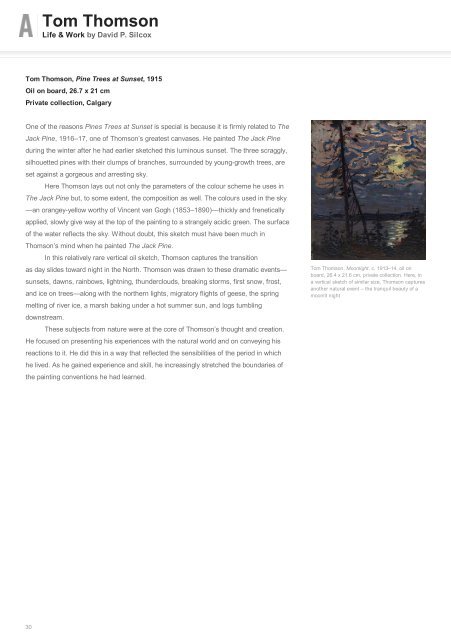You also want an ePaper? Increase the reach of your titles
YUMPU automatically turns print PDFs into web optimized ePapers that Google loves.
<strong>Tom</strong> <strong>Thomson</strong><br />
Life & Work by David P. Silcox<br />
<strong>Tom</strong> <strong>Thomson</strong>, Pine Trees at Sunset, 1915<br />
Oil on board, 26.7 x 21 cm<br />
Private collection, Calgary<br />
One of the reasons Pines Trees at Sunset is special is because it is firmly related to The<br />
Jack Pine, 1916–17, one of <strong>Thomson</strong>’s greatest canvases. He painted The Jack Pine<br />
during the winter after he had earlier sketched this luminous sunset. The three scraggly,<br />
silhouetted pines with their clumps of branches, surrounded by young-growth trees, are<br />
set against a gorgeous and arresting sky.<br />
Here <strong>Thomson</strong> lays out not only the parameters of the colour scheme he uses in<br />
The Jack Pine but, to some extent, the composition as well. The colours used in the sky<br />
—an orangey-yellow worthy of Vincent van Gogh (1853–1890)—thickly and frenetically<br />
applied, slowly give way at the top of the painting to a strangely acidic green. The surface<br />
of the water reflects the sky. Without doubt, this sketch must have been much in<br />
<strong>Thomson</strong>’s mind when he painted The Jack Pine.<br />
In this relatively rare vertical oil sketch, <strong>Thomson</strong> captures the transition<br />
as day slides toward night in the North. <strong>Thomson</strong> was drawn to these dramatic events—<br />
sunsets, dawns, rainbows, lightning, thunderclouds, breaking storms, first snow, frost,<br />
and ice on trees—along with the northern lights, migratory flights of geese, the spring<br />
melting of river ice, a marsh baking under a hot summer sun, and logs tumbling<br />
downstream.<br />
These subjects from nature were at the core of <strong>Thomson</strong>’s thought and creation.<br />
He focused on presenting his experiences with the natural world and on conveying his<br />
reactions to it. He did this in a way that reflected the sensibilities of the period in which<br />
he lived. As he gained experience and skill, he increasingly stretched the boundaries of<br />
the painting conventions he had learned.<br />
Fire-Swept Hills 1915<br />
<strong>Tom</strong> <strong>Thomson</strong>, Moonlight, c. 1913–14, oil on<br />
board, 26.4 x 21.6 cm, private collection. Here, in<br />
a vertical sketch of similar size, <strong>Thomson</strong> captures<br />
another natural event – the tranquil beauty of a<br />
moonlit night<br />
30


